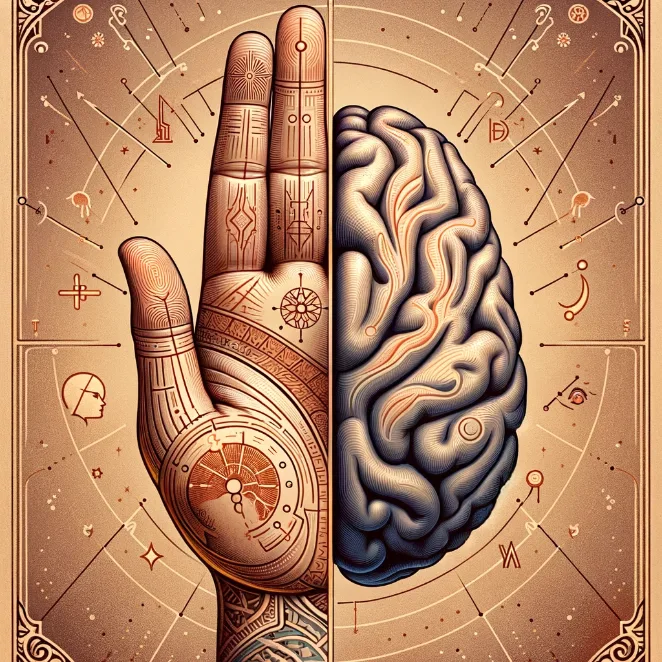
Palmistry: A Psychological Perspective
Today, we shift our focus from the mystical realm of palmistry to explore its connection with the science of psychology. Palmistry, traditionally seen as a method to predict the future based on the lines of the hand, aligns intriguingly with psychological concepts. This article delves into how the principles of psychology can be applied to palmistry, offering a scientific perspective on this ancient practice. We will define key concepts and explore what psychologists have to say about the psychological implications of palm reading.
article by Nora Pennington
Defining Palmistry in Psychological Terms
Palmistry, or chiromancy, is the practice of interpreting the lines and shapes in the hand to glean insights into a person's character or future. From a psychological viewpoint, palmistry can be seen as a tool for introspection and personality assessment, akin to projective tests used in psychology. The lines on the palm, such as the Heart Line or the Head Line, are not just mystical symbols but are often viewed as reflections of one's mental and emotional state. Renowned psychologist Carl Jung once said, “The hand has the richest psychological content, and studying it provides the greatest revelations.” This suggests a deep psychological underpinning to the art of palmistry.

The Psychological Comfort of Palm Reading
The psychological comfort derived from palmistry is a noteworthy aspect. People often turn to palm readings for reassurance about their future, a phenomenon understood in psychology as a coping mechanism for dealing with uncertainty. This need for reassurance can be linked to the concept of cognitive closure in psychology, which is the human desire for a clear, definitive answer to a question. As psychologist Jerome Kagan states, “The need for certainty is one of the deepest motives of the human spirit,” highlighting why many find solace in palm readings. Palmistry, in this regard, offers a form of psychological relief, providing comfort and certainty in an uncertain world.
Palmistry as a Reflective Psychological Tool
Incorporating palmistry as a reflective tool aligns with psychological practices that encourage self-awareness and personal growth. The analysis of palm lines can prompt individuals to reflect on their life choices, behaviors, and relationships. This process is similar to psychological introspection, where one examines their own thoughts and feelings. Reflecting on the interpretations of palm lines can lead to valuable personal insights, similar to how psychological assessments help individuals understand their behavioral patterns. This introspective process is often therapeutic and aids in personal development.

Understanding the Placebo Effect in Palmistry
The placebo effect, a well-known phenomenon in psychology, plays a significant role in the practice of palmistry. If a person believes that a palm reading will positively impact their life, this belief alone can initiate a change in their psychological state. This effect is not exclusive to medical treatments but extends to various belief-based practices, including palmistry. As psychologist Robert Rosenthal famously said, “When we expect certain behaviors of others, we are likely to act in ways that make the expected behavior more likely to occur.” The placebo effect in palmistry demonstrates how expectations and beliefs can shape our perceptions and experiences.
The Role of Symbolism in Palmistry and Psychology
The connection between palmistry and psychology deepens when we consider the role of symbolism. In palmistry, every line, curve, and mark on the palm is symbolic of different aspects of life and personality. Psychology, too, acknowledges the power of symbolism in understanding the subconscious mind. Symbols, whether in dreams or in the lines of the palm, act as mirrors reflecting our deepest thoughts, fears, and aspirations. Carl Jung's work on symbols and the collective unconscious underscores this point, showing how symbols from various cultures and practices, including palmistry, can tap into universal psychological themes. This shared use of symbolism bridges the gap between the seemingly mystical practice of palmistry and the empirical study of the human psyche.
Psychological Insights from Palm Lines
Palm lines can be seen as a physical manifestation of our mental and emotional pathways. Just as a psychologist interprets behavior to understand mental states, a palmist reads lines to glean insights into an individual’s character and potential life course. For example, a prominent and deep Head Line may indicate a strong intellectual capacity, akin to psychological interpretations of cognitive strengths. The Heart Line could offer insights into emotional responses and relational patterns, similar to how a psychologist might explore emotional intelligence and attachment styles. This parallel allows for a unique blend of palmistry and psychology, offering a holistic view of an individual’s inner workings.

Palmistry as a Projective Technique in Psychology
In some ways, palmistry can be compared to projective tests used in psychology, such as the Rorschach inkblot test. Both involve projecting one’s subconscious thoughts and feelings onto an external object or concept – the palm lines, in the case of palmistry. This projection allows individuals to explore aspects of their personality that may not be easily accessible through conscious introspection. While palmistry is not a scientifically validated psychological tool, its use in encouraging self-exploration and introspection can be compared to therapeutic techniques in psychology that aim to uncover deeper layers of the self. This makes palmistry not just a practice of divination, but also a means of self-discovery, resonating with psychological goals of understanding and personal growth.
In conclusion, when viewed through the lens of psychology, palmistry transcends its mystical origins and aligns with scientific understanding. It becomes a tool not for predicting the future, but for introspection, self-awareness, and psychological comfort. Understanding palmistry from a psychological perspective allows us to appreciate its role in personal development and mental well-being. While it remains distinct from empirical psychological practices, its value in fostering self-reflection and providing emotional solace is undeniable.
Published: 11/14/2023
Modified: 11/14/2023
More predictions
Come back here soon to learn more about yourself and your future


Love's Mysteries & Palm Reading Cards
Amara, an ardent believer in the interconnectedness of the universe, always felt a deep connection to the stars and the stories they held. As a child, she'd listen intently as her grandmother, a renowned palmist, would weave tales of fate, destiny, and love based on the intricate lines and patterns on one's palm.


The Mystique of Palm Reading Cards
The esoteric world of palmistry is not just confined to reading the hands directly but extends into diverse methods like palm reading cards, which facilitate a structured interpretation of palmistic symbols. A blend of tradition and innovation, these cards interweave the ancient wisdom of palmistry with a more accessible and user-friendly approach.


Beyond The Myths Of Hand Reading
Palmistry, a practice steeped in mysticism and antiquity, often wanders through shadows of myths, misunderstandings, and sometimes, sheer disbelief. As the murmurs of destiny and fortune waltz upon the lines etched in our hands, the moment is ripe to sift the truths from the tales and illuminate the authentic soul of palm reading.